2018 PEUGEOT 5008 ECO mode
[x] Cancel search: ECO modePage 5 of 364

3
.
bit.ly/helpPSA
.
Driving recommendations 155
Anti-theft protection 1 56
Starting/Switching off the engine with
the key
1
56
Starting/Switching off the engine with
K
eyless Entry and Starting
1
58
Electric parking brake
1
61
Manual gearbox
1
64
Automatic gearbox
1
65
Hill start assist
1
69
Dynamic pack
1
70
Gear shift indicator
1
70
Stop & Start
1
71
Under-inflation detection
1
74
Memorising speeds
1
75
Recognition of speed limit signs and
recommendation
1
76
Speed limiter
1
79
Cruise control
1
81
Adaptive cruise control
1
84
Distance Alert and Active Safety Brake
1
92
Fatigue detection system
1
96
Lane Departure Warning System
1
98
Active Lane Departure Warning System
1
98
Blind Spot Monitoring System
2
03
Parking sensors
2
05
Visiopark 1 - Visiopark 2
2
07
Park Assist
2
12Fuel
220
Misfuel prevention (Diesel) 2 21
Compatibility of fuels
2
22
Towing device
2
23
Towbar with quickly detachable towball
2
24
Load reduction mode
2
27
Energy economy mode
2
27
Very cold climate screen
2
28
Snow chains
2
28
Fitting roof bars
2
29
Bonnet
23
0
Engine compartment
2
31
Checking levels
23
2
Checks
235
AdBlue
® (BlueHDi engines) 2 37
Warning triangle
2
40
Running out of fuel (Diesel)
2
40
Tool kit
2
41
Temporary puncture repair kit
2
43
Spare wheel
2
46
Changing a
bulb
2
52
Changing a
wiper blade
2
57
Changing a
fuse
2
57
12
V battery
2
62
Towing the vehicle
2
65Engine technical data and towed loads
2
67
Petrol engines and towed loads
2
68
Diesel engines and towed loads
2
69
Dimensions
272
Identification markings
2
73
Driving
Practical information Technical data
Alphabetical index
In the event of a
breakdownAudio equipment and telematics
PEUGEOT Connect Nav
PEUGEOT Connect Radio
Bluetooth audio system
Access to additional videos
.
Contents
Page 8 of 364
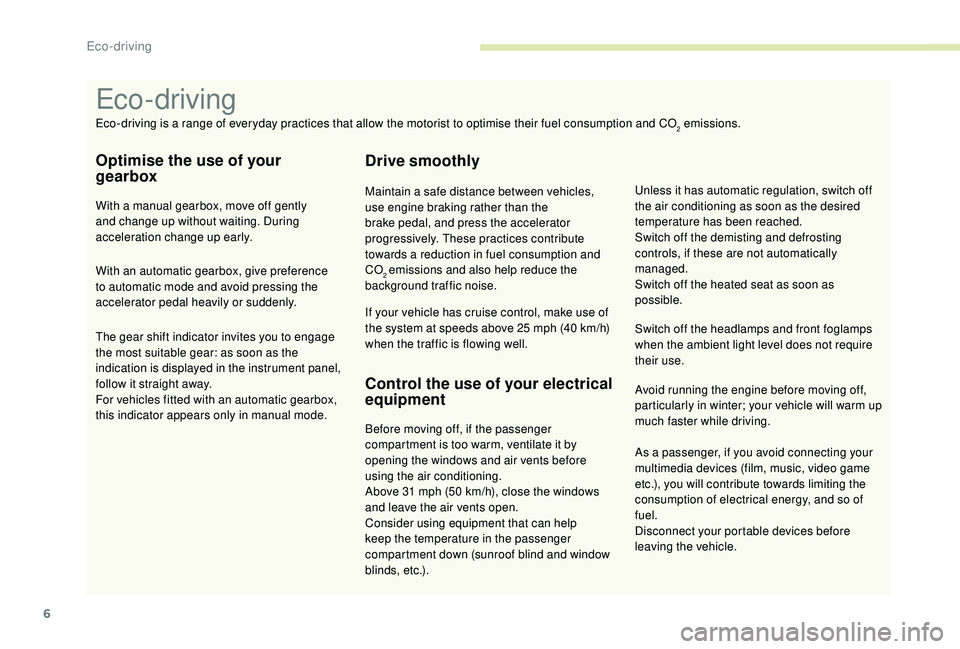
6
As a passenger, if you avoid connecting your
m ultimedia devices (film, music, video game
etc.), you will contribute towards limiting the
consumption of electrical energy, and so of
fuel.
Disconnect your portable devices before
leaving the vehicle.
Eco- driving
Eco-driving is a range of everyday practices that allow the motorist to optimise their fuel consumption and CO2 emissions.
Optimise the use of your
gearbox
With a manual gearbox, move off gently
an d change up without waiting. During
acceleration change up early.
With an automatic gearbox, give preference
to automatic mode and avoid pressing the
accelerator pedal heavily or suddenly.
The gear shift indicator invites you to engage
the most suitable gear: as soon as the
indication is displayed in the instrument panel,
follow it straight away.
For vehicles fitted with an automatic gearbox,
this indicator appears only in manual mode.
Drive smoothly
Maintain a safe distance between vehicles,
u se engine braking rather than the
brake pedal, and press the accelerator
progressively. These practices contribute
towards a
reduction in fuel consumption and
CO
2 emissions and also help reduce the
background traffic noise.
If your vehicle has cruise control, make use of
the system at speeds above 25
mph (40 km/h)
when the traffic is flowing well.
Control the use of your electrical
equipment
Before moving off, if the passenger
compartment is too warm, ventilate it by
opening the windows and air vents before
using the air conditioning.
Above 31
mph (50 km/h), close the windows
and leave the air vents open.
Consider using equipment that can help
keep the temperature in the passenger
compartment down (sunroof blind and window
blinds, etc.). Switch off the headlamps and front foglamps
when the ambient light level does not require
their use.
Avoid running the engine before moving off,
particularly in winter; your vehicle will warm up
much faster while driving. Unless it has automatic regulation, switch off
the air conditioning as soon as the desired
temperature has been reached.
Switch off the demisting and defrosting
controls, if these are not automatically
managed.
Switch off the heated seat as soon as
possible.
Eco-driving
Page 10 of 364
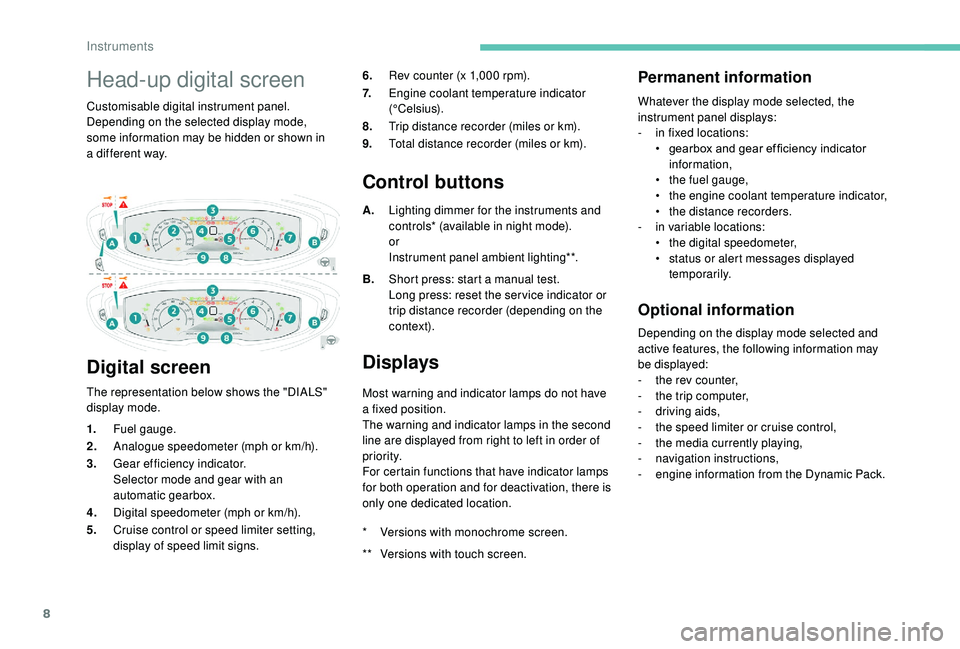
8
Head-up digital screen
Customisable digital instrument panel.
Depending on the selected display mode,
some information may be hidden or shown in
a different way.
Digital screen
The representation below shows the "DIALS"
display mode. 6.
Rev counter (x 1,000 rpm).
7. Engine coolant temperature indicator
(°Celsius).
8. Trip distance recorder (miles or km).
9. Total distance recorder (miles or km).
Control buttons
A.Lighting dimmer for the instruments and
controls* (available in night mode).
or
Instrument panel ambient lighting**.
B. Short press: start a
manual test.
Long press: reset the ser vice indicator or
trip distance recorder (depending on the
contex t).
Displays
Most warning and indicator lamps do not have
a fixed position.
The warning and indicator lamps in the second
line are displayed from right to left in order of
priority.
For certain functions that have indicator lamps
for both operation and for deactivation, there is
only one dedicated location.
Permanent information
Whatever the display mode selected, the
instrument panel displays:
-
i
n fixed locations:
•
g
earbox and gear ef ficiency indicator
information,
•
t
he fuel gauge,
•
t
he engine coolant temperature indicator,
•
t
he distance recorders.
-
i
n variable locations:
•
t
he digital speedometer,
•
s
tatus or alert messages displayed
temporarily.
Optional information
Depending on the display mode selected and
active features, the following information may
be displayed:
-
t
he rev counter,
-
t
he trip computer,
-
d
riving aids,
-
t
he speed limiter or cruise control,
-
t
he media currently playing,
-
n
avigation instructions,
-
e
ngine information from the Dynamic Pack.
1.
Fuel gauge.
2. Analogue speedometer (mph or km/h).
3. Gear efficiency indicator.
Selector mode and gear with an
automatic gearbox.
4. Digital speedometer (mph or km/h).
5. Cruise control or speed limiter setting,
display of speed limit signs. *
V
ersions with monochrome screen.
**
V
ersions with touch screen.
Instruments
Page 11 of 364

9
* Versions with monochrome screen.
**
V
ersions with touch screen.
Customisation of the
instrument panel
You can modify the appearance of the
instrument panel, by choosing:
-
t
he instrument panel display colour**,
-
a d
isplay mode.
Display language and units
They depend on the configuration of the
multifunction screen (configuration menu).
When travelling abroad, the speed must
be shown in the of ficial units of the
country you are driving in (km/h, km or
mph, miles).
As a
safety measure, these adjustments
must be carried out with the vehicle
stationary.
**
V
ersions with touch screen.
Choosing a display colour
This depends on the ambience activated by the
i- Cockpit Amplify function.
The possible choices are:
F
"Relax ": grey,
F
"Boost ": red,
F
"Normal " (no ambience activated): blue.
For more information on the i-Cockpit Amplify
function , refer to the corresponding section.
Choice of display mode
To modify the display mode of the instrument
panel:
F
T
urn the wheel located on the left of the
steering wheel to display and scroll through
the different modes on the right-hand side
of the instrument panel.
F
O
nce the selected display mode appears,
press on the wheel to validate.
The new display mode is applied instantly.
Each mode corresponds to the type of
information displayed in the instrument panel.
-
"
DIALS": standard display of the analogue
and digital speedometers, the rev counter,
the fuel gauge, the engine coolant
temperature indicator and the distance
recorders.
-
"
NAVIGATION": standard display also
showing the current navigation information
(map database and navigation instructions). -
"
DRIVING": standard display also showing
the current driving aid systems information.
-
"
MINIMAL": minimal display with digital
speedometer and the distance recorders
and, in the event of a warning only, the
fuel gauge and the coolant temperature
i n d i c a t o r.
-
"
TRIP COMPUTER"* minimal display also
showing the rev counter, current information
and the trip recorder selected (1 or 2).
or
-
"
PERSONAL"**: minimal display also
showing the selection made from the touch
screen of the type of information displayed
in the customisable areas on the left and
right.
To enter settings for the "PERSONAL"
display mode and select the information to
be displayed in the customisable areas of the
instrument panel:
or F
Sel
ect the Settings menu in the
upper bar of the touch screen.
1
Instruments
Page 13 of 364
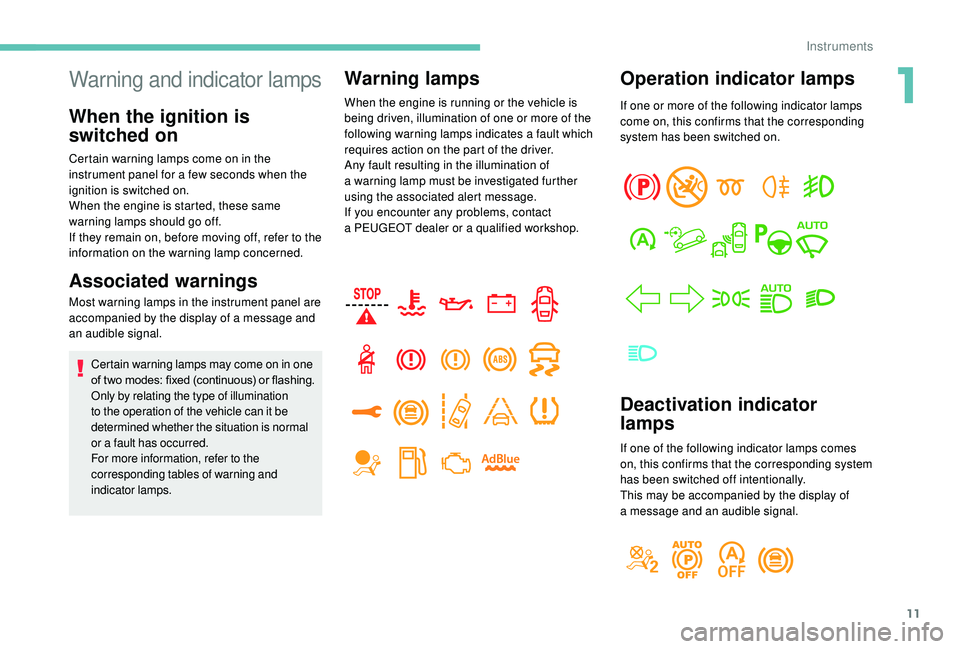
11
Operation indicator lamps
If one or more of the following indicator lamps
come on, this confirms that the corresponding
system has been switched on.
Deactivation indicator
lamps
If one of the following indicator lamps comes
on, this confirms that the corresponding system
has been switched off intentionally.
This may be accompanied by the display of
a
message and an audible signal.
When the engine is running or the vehicle is
being driven, illumination of one or more of the
following warning lamps indicates a
fault which
requires action on the part of the driver.
Any fault resulting in the illumination of
a
warning lamp must be investigated further
using the associated alert message.
If you encounter any problems, contact
a
PEUGEOT dealer or a
qualified workshop.
Warning and indicator lamps
When the ignition is
switched on
Certain warning lamps come on in the
instrument panel for a
few seconds when the
ignition is switched on.
When the engine is started, these same
warning lamps should go off.
If they remain on, before moving off, refer to the
information on the warning lamp concerned.
Associated warnings
Most warning lamps in the instrument panel are
accompanied by the display of a message and
an audible signal.
Certain warning lamps may come on in one
of two modes: fixed (continuous) or flashing.
Only by relating the type of illumination
to the operation of the vehicle can it be
determined whether the situation is normal
or a
fault has occurred.
For more information, refer to the
corresponding tables of warning and
indicator lamps.
Warning lamps
1
Instruments
Page 16 of 364
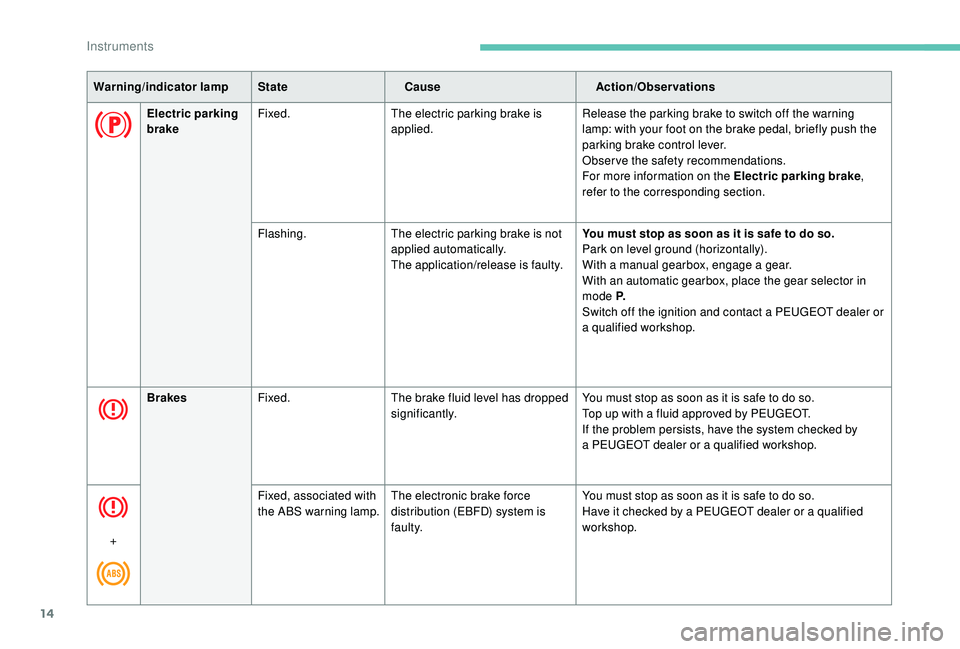
14
Warning/indicator lampStateCause Action/Observations
Electric parking
brake Fixed.
The electric parking brake is
applied. Release the parking brake to switch off the warning
lamp: with your foot on the brake pedal, briefly push the
parking brake control lever.
Observe the safety recommendations.
For more information on the Electric parking brake
,
refer to the corresponding section.
Flashing. The electric parking brake is not
applied automatically.
The application/release is faulty. You must stop as soon as it is safe to do so.
Park on level ground (horizontally).
With a
manual gearbox, engage a
gear.
With an automatic gearbox, place the gear selector in
mode P.
Switch off the ignition and contact a
PEUGEOT dealer or
a
qualified workshop.
Brakes Fixed. The brake fluid level has dropped
significantly. You must stop as soon as it is safe to do so.
Top up with a
fluid approved by PEUGEOT.
If the problem persists, have the system checked by
a
PEUGEOT dealer or a qualified workshop.
+ Fixed, associated with
the ABS warning lamp.
The electronic brake force
distribution (EBFD) system is
faulty. You must stop as soon as it is safe to do so.
Have it checked by a
PEUGEOT dealer or a qualified
workshop.
Instruments
Page 26 of 364
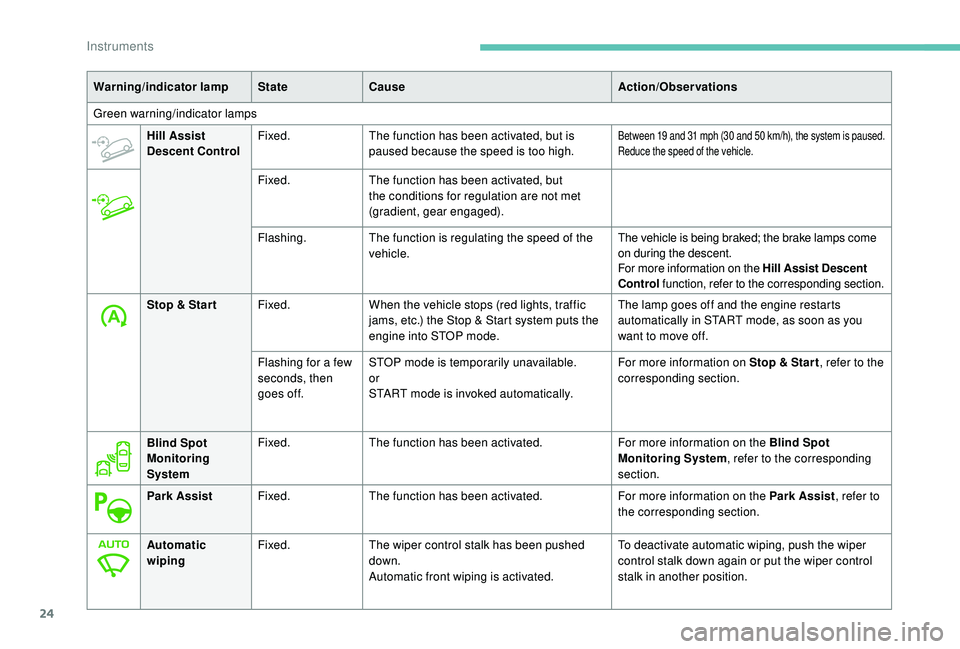
24
Warning/indicator lampStateCause Action/Observations
Green warning/indicator lamps Hill Assist
Descent Control Fixed.
The function has been activated, but is
paused because the speed is too high.
Between 19 and 31 mph (30 and 50 km/h), the system is paused.
R educe the speed of the vehicle.
Fixed. The function has been activated, but
the conditions for regulation are not met
(gradient, gear engaged).
Flashing. The function is regulating the speed of the
vehicle. The vehicle is being braked; the brake lamps come
on during the descent.
For more information on the Hill Assist Descent
Control
function, refer to the corresponding section.
Stop & Star t Fixed.When the vehicle stops (red lights, traffic
jams, etc.) the Stop & Start system puts the
engine into STOP mode. The lamp goes off and the engine restarts
automatically in START mode, as soon as you
want to move off.
Flashing for a
few
seconds, then
goes off. STOP mode is temporarily unavailable.
or
START mode is invoked automatically. For more information on Stop & Star t
, refer to the
corresponding section.
Blind Spot
Monitoring
System Fixed.
The function has been activated. For more information on the Blind Spot
Monitoring System, refer to the corresponding
section.
Park Assist Fixed.The function has been activated. For more information on the Park Assist, refer to
the corresponding section.
Automatic
wiping Fixed.
The wiper control stalk has been pushed
down.
Automatic front wiping is activated. To deactivate automatic wiping, push the wiper
control stalk down again or put the wiper control
stalk in another position.
Instruments
Page 30 of 364
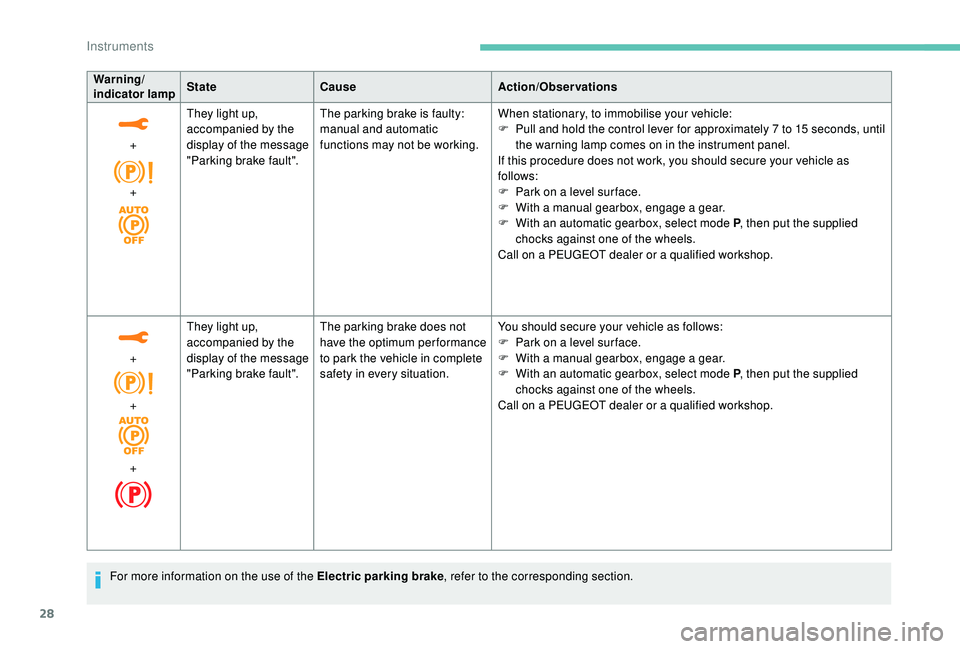
28
Warning/
indicator lampStateCause Action/Observations
+
+ They light up,
accompanied by the
display of the message
"Parking brake fault".
The parking brake is faulty:
manual and automatic
functions may not be working.
When stationary, to immobilise your vehicle:
F
P
ull and hold the control lever for approximately 7 to 15 seconds, until
the warning lamp comes on in the instrument panel.
If this procedure does not work, you should secure your vehicle as
follows:
F
P
ark on a level sur face.
F
W
ith a
manual gearbox, engage a
gear.
F
W
ith an automatic gearbox, select mode P, then put the supplied
chocks against one of the wheels.
Call on a
PEUGEOT dealer or a qualified workshop.
+
+
+ They light up,
accompanied by the
display of the message
"Parking brake fault".
The parking brake does not
have the optimum performance
to park the vehicle in complete
safety in every situation. You should secure your vehicle as follows:
F
P
ark on a level sur face.
F
W
ith a
manual gearbox, engage a
gear.
F
W
ith an automatic gearbox, select mode P, then put the supplied
chocks against one of the wheels.
Call on a
PEUGEOT dealer or a qualified workshop.
For more information on the use of the Electric parking brake , refer to the corresponding section.
Instruments